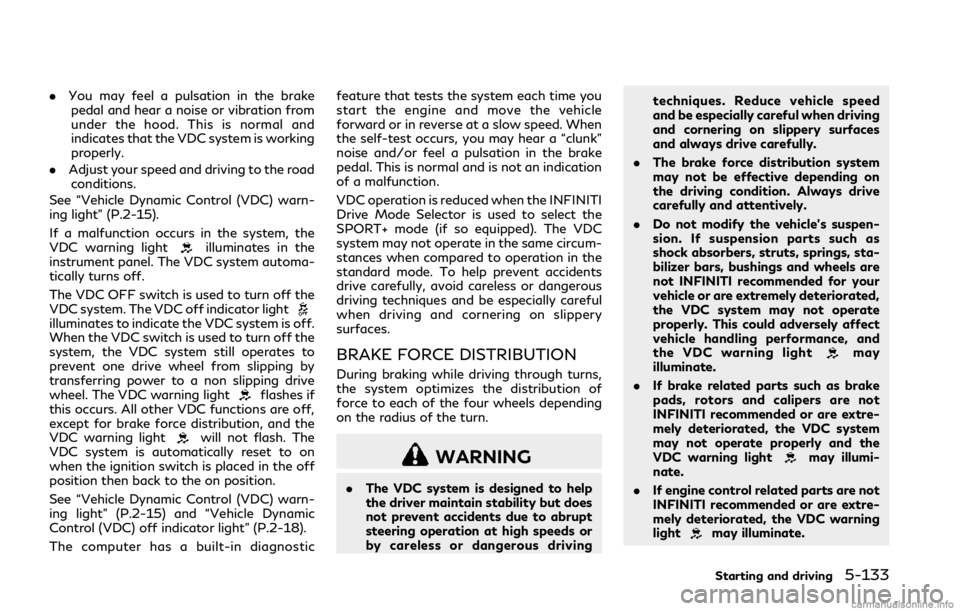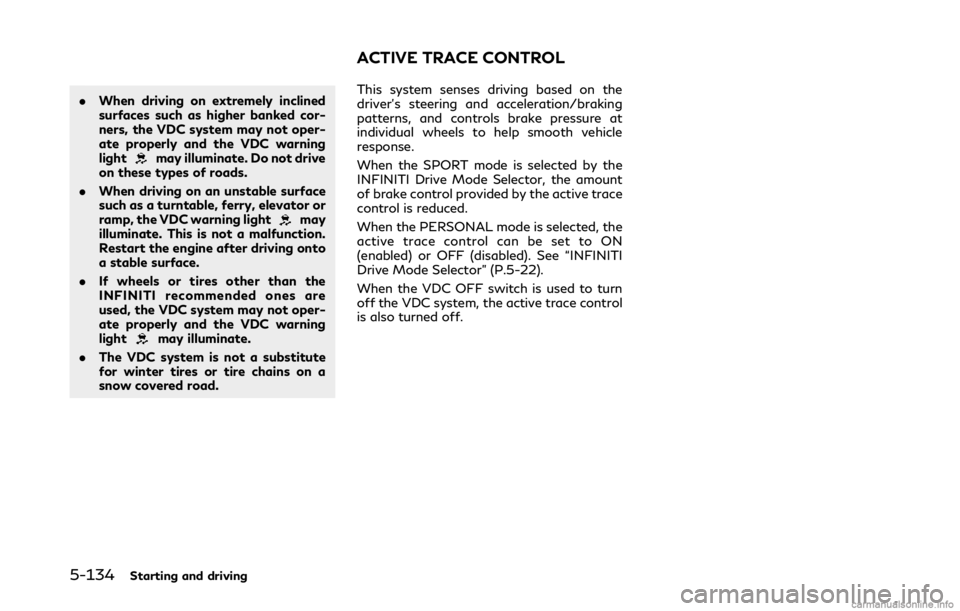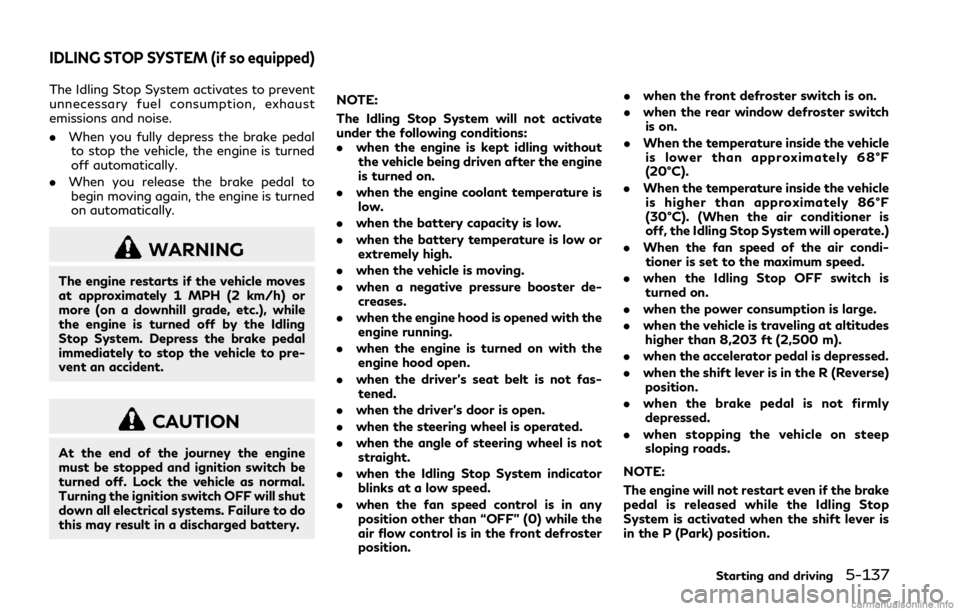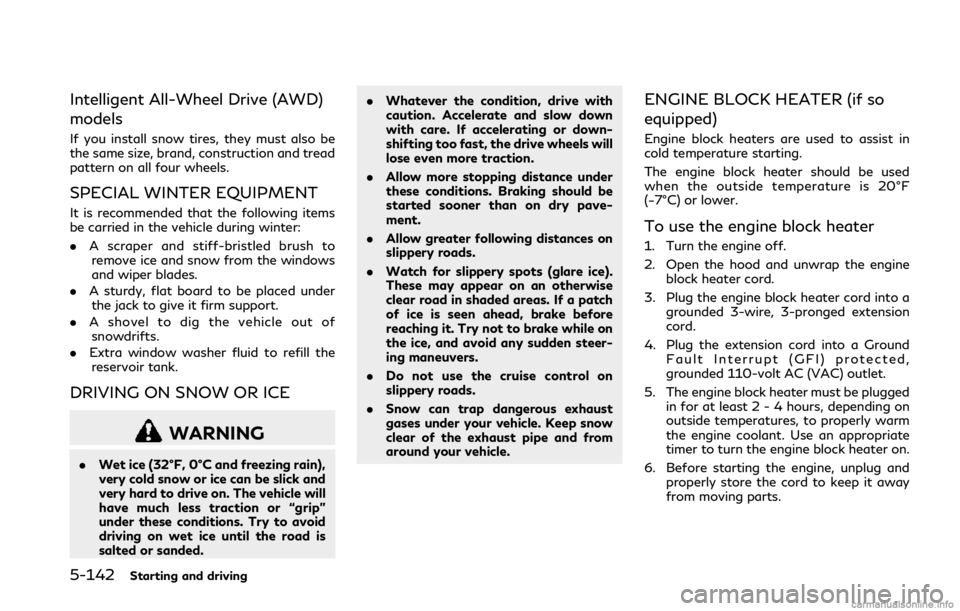engine INFINITI Q50 2018 Owner's Manual
[x] Cancel search | Manufacturer: INFINITI, Model Year: 2018, Model line: Q50, Model: INFINITI Q50 2018Pages: 458, PDF Size: 2.13 MB
Page 316 of 458

.You may feel a pulsation in the brake
pedal and hear a noise or vibration from
under the hood. This is normal and
indicates that the VDC system is working
properly.
. Adjust your speed and driving to the road
conditions.
See “Vehicle Dynamic Control (VDC) warn-
ing light” (P.2-15).
If a malfunction occurs in the system, the
VDC warning light
illuminates in the
instrument panel. The VDC system automa-
tically turns off.
The VDC OFF switch is used to turn off the
VDC system. The VDC off indicator light
illuminates to indicate the VDC system is off.
When the VDC switch is used to turn off the
system, the VDC system still operates to
prevent one drive wheel from slipping by
transferring power to a non slipping drive
wheel. The VDC warning light
flashes if
this occurs. All other VDC functions are off,
except for brake force distribution, and the
VDC warning light
will not flash. The
VDC system is automatically reset to on
when the ignition switch is placed in the off
position then back to the on position.
See “Vehicle Dynamic Control (VDC) warn-
ing light” (P.2-15) and “Vehicle Dynamic
Control (VDC) off indicator light” (P.2-18).
The computer has a built-in diagnostic feature that tests the system each time you
start the engine and move the vehicle
forward or in reverse at a slow speed. When
the self-test occurs, you may hear a “clunk”
noise and/or feel a pulsation in the brake
pedal. This is normal and is not an indication
of a malfunction.
VDC operation is reduced when the INFINITI
Drive Mode Selector is used to select the
SPORT+ mode (if so equipped). The VDC
system may not operate in the same circum-
stances when compared to operation in the
standard mode. To help prevent accidents
drive carefully, avoid careless or dangerous
driving techniques and be especially careful
when driving and cornering on slippery
surfaces.
BRAKE FORCE DISTRIBUTION
During braking while driving through turns,
the system optimizes the distribution of
force to each of the four wheels depending
on the radius of the turn.
WARNING
.
The VDC system is designed to help
the driver maintain stability but does
not prevent accidents due to abrupt
steering operation at high speeds or
by careless or dangerous driving techniques. Reduce vehicle speed
and be especially careful when driving
and cornering on slippery surfaces
and always drive carefully.
. The brake force distribution system
may not be effective depending on
the driving condition. Always drive
carefully and attentively.
. Do not modify the vehicle’s suspen-
sion. If suspension parts such as
shock absorbers, struts, springs, sta-
bilizer bars, bushings and wheels are
not INFINITI recommended for your
vehicle or are extremely deteriorated,
the VDC system may not operate
properly. This could adversely affect
vehicle handling performance, and
the VDC warning light
may
illuminate.
. If brake related parts such as brake
pads, rotors and calipers are not
INFINITI recommended or are extre-
mely deteriorated, the VDC system
may not operate properly and the
VDC warning light
may illumi-
nate.
. If engine control related parts are not
INFINITI recommended or are extre-
mely deteriorated, the VDC warning
light
may illuminate.
Starting and driving5-133
Page 317 of 458

5-134Starting and driving
.When driving on extremely inclined
surfaces such as higher banked cor-
ners, the VDC system may not oper-
ate properly and the VDC warning
light
may illuminate. Do not drive
on these types of roads.
. When driving on an unstable surface
such as a turntable, ferry, elevator or
ramp, the VDC warning light
may
illuminate. This is not a malfunction.
Restart the engine after driving onto
a stable surface.
. If wheels or tires other than the
INFINITI recommended ones are
used, the VDC system may not oper-
ate properly and the VDC warning
light
may illuminate.
. The VDC system is not a substitute
for winter tires or tire chains on a
snow covered road. This system senses driving based on the
driver’s steering and acceleration/braking
patterns, and controls brake pressure at
individual wheels to help smooth vehicle
response.
When the SPORT mode is selected by the
INFINITI Drive Mode Selector, the amount
of brake control provided by the active trace
control is reduced.
When the PERSONAL mode is selected, the
active trace control can be set to ON
(enabled) or OFF (disabled). See “INFINITI
Drive Mode Selector” (P.5-22).
When the VDC OFF switch is used to turn
off the VDC system, the active trace control
is also turned off.
ACTIVE TRACE CONTROL
Page 320 of 458

The Idling Stop System activates to prevent
unnecessary fuel consumption, exhaust
emissions and noise.
.When you fully depress the brake pedal
to stop the vehicle, the engine is turned
off automatically.
. When you release the brake pedal to
begin moving again, the engine is turned
on automatically.
WARNING
The engine restarts if the vehicle moves
at approximately 1 MPH (2 km/h) or
more (on a downhill grade, etc.), while
the engine is turned off by the Idling
Stop System. Depress the brake pedal
immediately to stop the vehicle to pre-
vent an accident.
CAUTION
At the end of the journey the engine
must be stopped and ignition switch be
turned off. Lock the vehicle as normal.
Turning the ignition switch OFF will shut
down all electrical systems. Failure to do
this may result in a discharged battery. NOTE:
The Idling Stop System will not activate
under the following conditions:
.
when the engine is kept idling without
the vehicle being driven after the engine
is turned on.
. when the engine coolant temperature is
low.
. when the battery capacity is low.
. when the battery temperature is low or
extremely high.
. when the vehicle is moving.
. when a negative pressure booster de-
creases.
. when the engine hood is opened with the
engine running.
. when the engine is turned on with the
engine hood open.
. when the driver’s seat belt is not fas-
tened.
. when the driver’s door is open.
. when the steering wheel is operated.
. when the angle of steering wheel is not
straight.
. when the Idling Stop System indicator
blinks at a low speed.
. when the fan speed control is in any
position other than “OFF” (0) while the
air flow control is in the front defroster
position. .
when the front defroster switch is on.
. when the rear window defroster switch
is on.
. When the temperature inside the vehicle
is lower than approximately 68°F
(20°C).
. When the temperature inside the vehicle
is higher than approximately 86°F
(30°C). (When the air conditioner is
off, the Idling Stop System will operate.)
. When the fan speed of the air condi-
tioner is set to the maximum speed.
. when the Idling Stop OFF switch is
turned on.
. when the power consumption is large.
. when the vehicle is traveling at altitudes
higher than 8,203 ft (2,500 m).
. when the accelerator pedal is depressed.
. when the shift lever is in the R (Reverse)
position.
. when the brake pedal is not firmly
depressed.
. when stopping the vehicle on steep
sloping roads.
NOTE:
The engine will not restart even if the brake
pedal is released while the Idling Stop
System is activated when the shift lever is
in the P (Park) position.
Starting and driving5-137
IDLING STOP SYSTEM (if so equipped)
Page 321 of 458

5-138Starting and driving
NOTE:
It may take some time until the Idling Stop
System activates under the following con-
ditions:
.when the battery is discharged.
. when the outside temperature is low or
high.
. when the battery is replaced or the
battery terminal is disconnected for
extended periods and then reconnected.
NOTE:
When the Idling Stop System indicator light
illuminates, the engine starts running auto-
matically under at least one of the following
conditions:
. The brake pedal is released with the shift
lever in the D (Drive) or N (Neutral)
position.
. The shift lever is placed in the D (Drive)
or R (Reverse) position from the N
(Neutral) or P (Park) position.
. The driver’s seat belt is unfastened, or
the driver’s door is open.
. The battery voltage becomes low (due to
electrical load from other vehicle sys-
tems like headlights, heaters, etc., or
auxiliary devices connected to the 12
volt socket inside the vehicle).
. The vehicle speed is above about 1 MPH
(2 km/h). .
The front defroster is operated.
. The rear window defroster is operated.
. When the temperature inside the vehicle
is lower than approximately 68°F
(20°C).
. When the temperature inside the vehicle
is higher than approximately 86°F
(30°C). (When the air conditioner is
off, the Idling Stop System will operate.)
. When the front defroster is turned on.
(The engine may not starts depending
on the outside temperature.)
. When more than 3 minutes have elapsed
since the Idling Stop System was active.
. When the accelerator pedal is depressed.
. When the steering wheel is operated.
(The steering wheel operation may be-
come heavy, but this is not a malfunc-
tion.)
. When the battery capacity is low.
. When the power consumption is high.
. When the shift lever is placed in the R
(Reverse) position.
NOTE:
The following condition will prevent the
Idling Stop System from automatically re-
starting the engine. Starting the engine
with the ignition switch operation is then
necessary: .
The hood is open.
Use this system while waiting at stoplight,
etc. When the vehicle is stopped for long
periods of time, turn off the engine.
When the engine is stopped by the Idling
Stop System, heating, cooling and dehumi-
difying functions will be deactivated. To
avoid the air conditioning functions from
being deactivated, turn off the Idling Stop
mode by pushing the Idling Stop OFF switch.
RETROGRADE MOVEMENT
CONTROL FUNCTION
This system is designed to reduce the retro-
grade movement that occurs while the
driver’s foot changes from depressing the
brake pedal to the accelerator pedal when
moving the vehicle while the Idling Stop
System is active on a hilly road.
IDLING STOP SYSTEM DISPLAY
The status of the Idling Stop System can be
checked in the vehicle information display.
Page 322 of 458

JVS0342X
Idling Stop System ON or OFF
If the Idling Stop System is activated or
deactivated using the Idling Stop OFF
switch, the message is shown.
JVS0904X
Fuel saved and engine stop time
The fuel saved and the engine stop time
mode shows the following items:
.The fuel saved shows the estimated
quantity of fuel that were saved by the
Idling Stop System every time the engine
is automatically stopped.
. The engine stop time shows the time that
the engine has been stopped for by the
Idling Stop System.
The total fuel saved and the engine stop time
can also be checked in the vehicle informa-
tion display. See “4. Trip fuel saved and
engine stop time” (P.2-27) and “5. Total fuel
saved and engine stop time” (P.2-28).
JVS0344X
Auto start deactivation
If the engine stops when the Idling Stop
System is activated, and will not start
automatically, the message is shown.
Starting and driving5-139
Page 323 of 458

5-140Starting and driving
JVS0345X
Key LOCK warning
The information is displayed and a buzzer
sounded to remind the driver to place the
ignition switch in the OFF position to avoid a
discharged battery.
The message can be cleared by placing the
ignition switch in the OFF position (or
restarting the engine) or pushing the
orswitch on the steering wheel.
JVS0346X
System fault
This message is displayed when the Idling
Stop System is malfunctioning.
It is recommended you have the system
checked by an INFINITI retailer.
JVS0269X
IDLING STOP OFF SWITCH
The system can be temporarily deactivated
by pushing the Idling Stop OFF switch.
Pushing the switch again or restarting the
engine by using the ignition switch will
reactivate the Idling Stop System.
.When the Idling Stop System is deacti-
vated while the engine is running, the
engine is prevented from automatically
stopping.
. When the Idling Stop System is deacti-
vated after the engine has been auto-
matically stopped by the Idling Stop
System, the engine will immediately
restart if suitable conditions are present.
The engine will then be prevented from
Page 324 of 458

automatically stopping during the same
journey.
. Whenever the Idling Stop System is
deactivated the indicator light
on the
Idling Stop OFF switch illuminates. In
this condition the Idling Stop System
cannot prevent unnecessary fuel con-
sumption, exhaust emissions, or noise
during your journey.
. If the Idling Stop System is malfunction-
ing, the indicator light
on the Idling
Stop OFF switch illuminates.
NOTE:
The Idling Stop System ON or OFF message
is displayed for a few seconds in the vehicle
information display when the Idling Stop
OFF switch is pushed. See “Idling Stop
System ON or OFF” (P.5-139).
FREEING A FROZEN DOOR LOCK
To prevent a door lock from freezing, apply
deicer through the key hole. If the lock
becomes frozen, heat the key before insert-
ing it into the key hole or use the Intelligent
Key system.
ANTIFREEZE
In the winter when it is anticipated that the
outside temperature will drop below 32°F
(0°C), check antifreeze to assure proper
winter protection. For additional informa-
tion, see “Engine cooling system (for
VR30DDTT engine models)” (P.8-6), “En-
gine cooling system (for 2.0L turbo gasoline
engine models)” (P.8-8) or “Intercooler cool-
ing system (for VR30DDTT engine models)”
(P.8-9).
BATTERY
If the battery is not fully charged during
extremely cold weather conditions, the bat-
tery fluid may freeze and damage the
battery. To maintain maximum efficiency,
the battery should be checked regularly. For
additional information, see “Battery” (P.8-
16).
DRAINING OF COOLANT WATER
If the vehicle is to be left outside without
antifreeze, drain the cooling system, includ-
ing the engine block. Refill before operating
the vehicle. For details, see “Engine cooling
system (for VR30DDTT engine models)”
(P.8-6) or “Engine cooling system (for 2.0L
turbo gasoline engine models)” (P.8-8).
TIRE EQUIPMENT
SUMMER tires have a tread designed to
provide superior performance on dry pave-
ment. However, the performance of these
tires will be substantially reduced in snowy
and icy conditions. If you operate your
vehicle on snowy or icy roads, INFINITI
recommends the use of MUD & SNOW or
ALL SEASON tires on all four wheels. It is
recommended you consult an INFINITI re-
tailer for the tire type, size, speed rating and
availability information.
For additional traction on icy roads, studded
tires may be used. However, some U.S.
states and Canadian provinces prohibit their
use. Check local, state and provincial laws
before installing studded tires.
Skid and traction capabilities of studded
snow tires, on wet or dry surfaces, may be
poorer than that of non-studded snow tires.
Tire chains may be used. For details, see
“Tire chains” (P.8-40) of this manual.
Starting and driving5-141
COLD WEATHER DRIVING
Page 325 of 458

5-142Starting and driving
Intelligent All-Wheel Drive (AWD)
models
If you install snow tires, they must also be
the same size, brand, construction and tread
pattern on all four wheels.
SPECIAL WINTER EQUIPMENT
It is recommended that the following items
be carried in the vehicle during winter:
.A scraper and stiff-bristled brush to
remove ice and snow from the windows
and wiper blades.
. A sturdy, flat board to be placed under
the jack to give it firm support.
. A shovel to dig the vehicle out of
snowdrifts.
. Extra window washer fluid to refill the
reservoir tank.
DRIVING ON SNOW OR ICE
WARNING
. Wet ice (32°F, 0°C and freezing rain),
very cold snow or ice can be slick and
very hard to drive on. The vehicle will
have much less traction or “grip”
under these conditions. Try to avoid
driving on wet ice until the road is
salted or sanded. .
Whatever the condition, drive with
caution. Accelerate and slow down
with care. If accelerating or down-
shifting too fast, the drive wheels will
lose even more traction.
. Allow more stopping distance under
these conditions. Braking should be
started sooner than on dry pave-
ment.
. Allow greater following distances on
slippery roads.
. Watch for slippery spots (glare ice).
These may appear on an otherwise
clear road in shaded areas. If a patch
of ice is seen ahead, brake before
reaching it. Try not to brake while on
the ice, and avoid any sudden steer-
ing maneuvers.
. Do not use the cruise control on
slippery roads.
. Snow can trap dangerous exhaust
gases under your vehicle. Keep snow
clear of the exhaust pipe and from
around your vehicle.
ENGINE BLOCK HEATER (if so
equipped)
Engine block heaters are used to assist in
cold temperature starting.
The engine block heater should be used
when the outside temperature is 20°F
(−7°C) or lower.
To use the engine block heater
1. Turn the engine off.
2. Open the hood and unwrap the engine
block heater cord.
3. Plug the engine block heater cord into a grounded 3-wire, 3-pronged extension
cord.
4. Plug the extension cord into a Ground Fault Interrupt (GFI) protected,
grounded 110-volt AC (VAC) outlet.
5. The engine block heater must be plugged in for at least 2 - 4 hours, depending on
outside temperatures, to properly warm
the engine coolant. Use an appropriate
timer to turn the engine block heater on.
6. Before starting the engine, unplug and properly store the cord to keep it away
from moving parts.
Page 326 of 458

WARNING
.Do not use your engine block heater
with an ungrounded electrical system
or a 2-pronged adapter. You can be
seriously injured by an electrical
shock if you use an ungrounded
connection.
. Disconnect and properly store the
engine block heater cord before
starting the engine. Damage to the
cord could result in an electrical shock
and can cause serious injury.
. Use a heavy-duty 3-wire, 3-pronged
extension cord rated for at least 10A.
Plug the extension cord into a Ground
Fault Interrupt (GFI) protected,
grounded 110-VAC outlet. Failure
to use the proper extension cord or
a grounded outlet can result in a fire
or electrical shock and cause serious
personal injury.
JVS0263X
NOTE:
To operate the active noise cancellation and
active sound enhancement system properly:
.Do not cover the speakers or woofer.
. Do not cover the microphones. .
Do not change or modify speakers in-
cluding the woofer and any audio related
parts such as the amplifier.
. Do not make any modification including
sound deadening or modifications
around the microphones, speakers or
woofer.
Starting and driving5-143
ACTIVE NOISE CANCELLATION/
ACTIVE SOUND ENHANCEMENT
Page 327 of 458

5-144Starting and driving
ACTIVE NOISE CANCELLATION
The active noise cancellation uses micro-
phoneslocated inside the vehicle to detect
engine booming noises. The system then
automatically produces a muted engine
booming noise through the speakers
and
woofer(if so equipped) to reduce engine
booming noise.
If the microphone
or the area around it is
tapped, abnormal noise may be output from
the speaker.
ACTIVE SOUND ENHANCEMENT
The active sound enhancement generates
sounds according to engine speed and
driving modes through the speakers
and
woofer(if so equipped) to enhance the
quality of the engine sound.